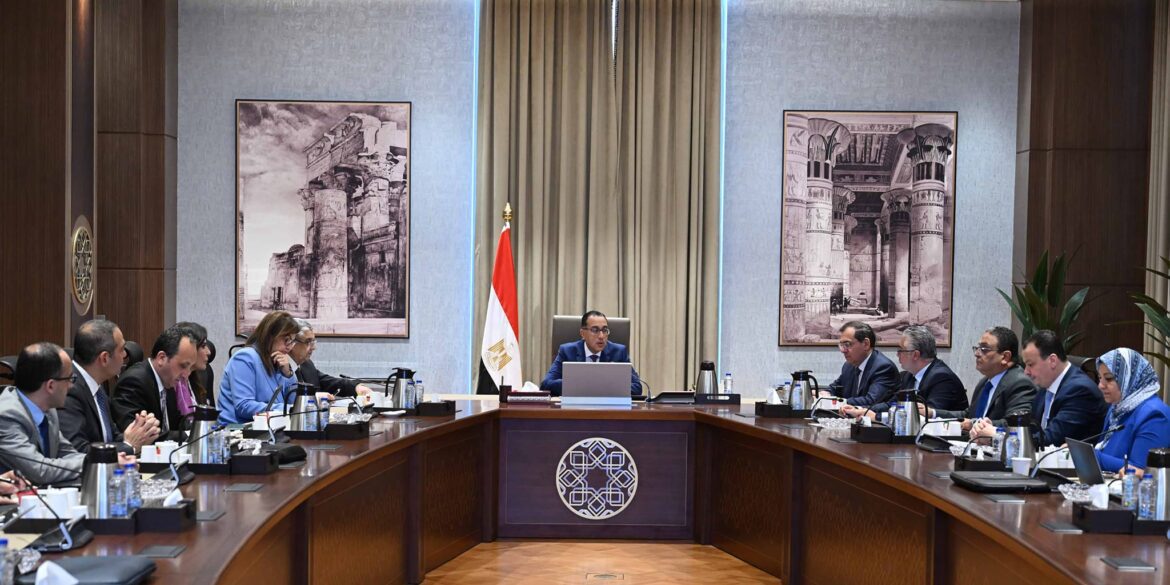Today, Dr. Mostafa Madbouly, Prime Minister, held a meeting at the government headquarters in the New Administrative Capital, to follow up on the position of green hydrogen projects, in the presence of Dr. Mohamed Shaker, Minister of Electricity and Renewable Energy, Engineer Tariq El Molla, Minister of Petroleum and Mineral Resources, and Dr. Hala Al-Saeed, Minister of Planning and Development. The Economy, Mr. Walid Gamal El-Din, Chairman of the General Authority for the Suez Canal Economic Zone, Engineer Randa El-Minshawy, First Assistant to the Prime Minister, Head of the Technical Secretariat of the National Council for Green Hydrogen, Mr. Ayman Soliman, Executive Director of the Sovereign Fund of Egypt, and Dr. Mohamed El-Khayyat, Chairman of the Energy Authority. New and renewed, and officials of ministries and concerned authorities.
Dr. Mostafa Madbouly began the meeting by emphasizing that the Egyptian government has an ambitious plan to enhance its capabilities in the field of using new and renewable energy, especially energy generated from green hydrogen, which contributes to reducing dependence on traditional fuels and reducing carbon emissions, indicating that Egypt has great capabilities. This qualifies it to be a regional center for the production and export of green hydrogen, especially in light of the green hydrogen strategy that was approved and grants many advantages and incentives to this promising sector, in line with the state’s efforts related to attracting local and global investments, and in line with the requirements of sustainable development.
The Prime Minister also stressed that the goal of this meeting is to follow up on the procedures for converting a number of framework agreements on green hydrogen into contracts for these projects, stressing the need to take quick measures in this file, to complement the steps taken by the state in this field.
During the meeting, Engineer Randa Al-Minshawi, First Assistant to the Prime Minister and Head of the Technical Secretariat of the National Green Hydrogen Council, reviewed the efforts made through the work of the Technical Secretariat, where she explained that 27 valid memorandums of understanding had been signed, 10 binding framework agreements, and preparations are underway to sign two agreements. Two binding frames.In this context, engineer Randa El-Minshawy indicated that several meetings have been held with the European Union regarding hydrogen projects in Egypt, and a meeting will also be held with the head of the energy sector in the European Union.
In a related context, the First Assistant to the Prime Minister pointed out that there is cooperation with the Ministry of Foreign Affairs regarding the mechanisms for implementing the hydrogen strategy, noting that several meetings were held with the Organization for Economic Cooperation and Development (OECD) in the presence of all stakeholders and investors in this regard, in addition to the periodic meetings of the committee. Executive committee to solve the problems of investors and lands related to projects and follow up studies.
Mr. Ayman Soliman, Executive Director of the Sovereign Fund of Egypt, presented the developments of the green hydrogen program, where he reviewed the proposal for the second incentive package for the program, and the proposed criteria for signing new memorandums of understanding within the program, in addition to requests for new projects for which it is proposed to sign memorandums of understanding.
Dr. Mohammed Al-Khayyat, Chairman of the New and Renewable Energy Authority, also presented the position of lands for renewable energy projects to produce green hydrogen. With the lands allocated to the New and Renewable Energy Authority, he explained that about 41.7 thousand square kilometers have already been allocated, and procedures for allocating an additional 900 square kilometers are being completed, to expand the implementation of these promising projects.
The Chairman of the Authority added that the locations of green hydrogen production projects were distributed to 27 memorandums of understanding signed with several investors, with a total capacity of about 115 gigawatts, including 63 gigawatts of wind energy and 52 gigawatts of solar energy.
Dr. Mohamed Al-Khayyat also touched on the position of the lands being allocated to renewable energy projects from the sun and wind, explaining that it was approved to allocate plots of land in the Red Sea and Suez governorates, to be used in establishing renewable energy plants, which can accommodate capacities of about 4.4 gigawatts of wind energy, and 11 gigawatts of solar energy. solar energy


